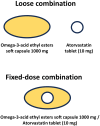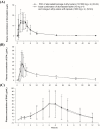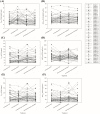Pharmacokinetic Comparison Between a Fixed-Dose Combination of Atorvastatin/Omega-3-Acid Ethyl Esters and the Corresponding Loose Combination in Healthy Korean Male Subjects
- PMID: 38352172
- PMCID: PMC10861834
- DOI: 10.2147/DDDT.S435885
Pharmacokinetic Comparison Between a Fixed-Dose Combination of Atorvastatin/Omega-3-Acid Ethyl Esters and the Corresponding Loose Combination in Healthy Korean Male Subjects
Abstract
Purpose: Statins are widely used in combination with omega-3 fatty acids for the treatment of patients with dyslipidemia. The aim of this study was to compare the pharmacokinetic (PK) profiles of atorvastatin and omega-3-acid ethyl esters between fixed-dose combination (FDC) and loose combination in healthy subjects.
Methods: A randomized, open-label, single-dose, 2-sequence, 2-treatment, 4-period replicated crossover study was performed. Subjects were randomly assigned to one of the 2 sequences and alternately received four FDC soft capsules of atorvastatin/omega-3-acid ethyl esters (10/1000 mg) or a loose combination of atorvastatin tablets (10 mg × 4) and omega-3-acid ethyl ester soft capsules (1000 mg× 4) for four periods, each period accompanied by a high-fat meal. Serial blood samples were collected for PK analysis of atorvastatin, eicosapentaenoic acid (EPA), and docosahexaenoic acid (DHA). PK parameters were calculated by a non-compartmental analysis. The geometric mean ratio (GMR) and its 90% confidence interval (CI) of the FDC to the loose combination were calculated to compare PK parameters.
Results: A total of 43 subjects completed the study as planned. The GMR (90% CI) of FDC to loose combination for maximum concentration (Cmax) and area under the time-concentration curve from zero to the last measurable point (AUClast) were 1.0931 (1.0054-1.1883) and 0.9885 (0.9588-1.0192) for atorvastatin, 0.9607 (0.9068-1.0178) and 0.9770 (0.9239-1.0331) for EPA, and 0.9961 (0.9127-1.0871) and 0.9634 (0.8830-1.0512) for DHA, respectively. The intra-subject variability for Cmax and AUClast of DHA was 30.8% and 37.5%, respectively, showing high variability. Both the FDC and the loose combination were safe and well tolerated.
Conclusion: The FDC of atorvastatin and omega-3-acid ethyl esters showed comparable PK characteristics to the corresponding loose combination, offering a convenient therapeutic option for the treatment of dyslipidemia.
Keywords: cardiovascular disease; pharmacokinetics.
© 2024 Khwarg et al.
Conflict of interest statement
Won-Ho Kang, Youn Woong Choi, Dae Chul Ha, RaeHoon Jung, Min-Gu Han, Won Tae Jung, Kyu-Yeol Nam, and YeSeul Kim are employees of Korea United Pharm. Inc. Hye Jung Lee, Kyu Yeon Kim, Ki-Sun Jeong, and Chongho Won are employees of Caleb Multilab, Inc. The other authors do not have any conflicts of interest for this study.
Figures





Similar articles
-
Comparison of the Pharmacokinetics of Highly Variable Drugs in Healthy Subjects Using a Partial Replicated Crossover Study: A Fixed-Dose Combination of Fimasartan 120 mg and Atorvastatin 40 mg versus Separate Tablets.Drug Des Devel Ther. 2020 May 20;14:1953-1961. doi: 10.2147/DDDT.S233732. eCollection 2020. Drug Des Devel Ther. 2020. PMID: 32546962 Free PMC article. Clinical Trial.
-
Pharmacokinetic comparison between fixed-dose combination of fimasartan/amlodipine 60/10 mg and the corresponding loose combination through partial replicated crossover study in healthy subjects.Transl Clin Pharmacol. 2019 Dec;27(4):134-140. doi: 10.12793/tcp.2019.27.4.134. Epub 2019 Dec 31. Transl Clin Pharmacol. 2019. PMID: 32095481 Free PMC article.
-
Pharmacokinetic comparison between a fixed-dose combination of fimasartan/amlodipine/hydrochlorothiazide 60/10/25 mg and a corresponding loose combination of fimasartan/amlodipine 60/25 mg and hydrochlorothiazide 25 mg in healthy subjects.Transl Clin Pharmacol. 2021 Mar;29(1):53-64. doi: 10.12793/tcp.2021.29.e5. Epub 2021 Mar 22. Transl Clin Pharmacol. 2021. PMID: 33855001 Free PMC article.
-
Investigation of bioequivalence of a new fixed-dose combination of acarbose and metformin with the corresponding loose combination as well as the drug-drug interaction potential between both drugs in healthy adult male subjects.J Clin Pharm Ther. 2014 Aug;39(4):424-31. doi: 10.1111/jcpt.12166. Epub 2014 May 8. J Clin Pharm Ther. 2014. PMID: 24806030 Clinical Trial.
-
Update on marine omega-3 fatty acids: management of dyslipidemia and current omega-3 treatment options.Atherosclerosis. 2013 Oct;230(2):381-9. doi: 10.1016/j.atherosclerosis.2013.07.041. Epub 2013 Jul 31. Atherosclerosis. 2013. PMID: 24075771 Review.
References
-
- Nikos Pappan AR. Dyslipidemia. Treasure Island (FL): StatPearls Publishing; 2022. - PubMed
-
- Ference BA, Ginsberg HN, Graham I, et al. Low-density lipoproteins cause atherosclerotic cardiovascular disease. 1. evidence from genetic, epidemiologic, and clinical studies. A consensus statement from the European Atherosclerosis Society Consensus Panel. Eur Heart J. 2017;38(32):2459–2472. doi:10.1093/eurheartj/ehx144 - DOI - PMC - PubMed
-
- Grundy SM, Stone NJ, Bailey AL, et al. 2018 AHA/ACC/AACVPR/AAPA/ABC/ACPM/ADA/AGS/APhA/ASPC/NLA/PCNA guideline on the management of blood cholesterol: a report of the American College of Cardiology/American Heart Association task force on clinical practice guidelines. J Am Coll Cardiol. 2019;73(24):e285–e350. doi:10.1016/j.jacc.2018.11.003 - DOI - PubMed
Publication types
MeSH terms
Substances
LinkOut - more resources
Full Text Sources
Research Materials

